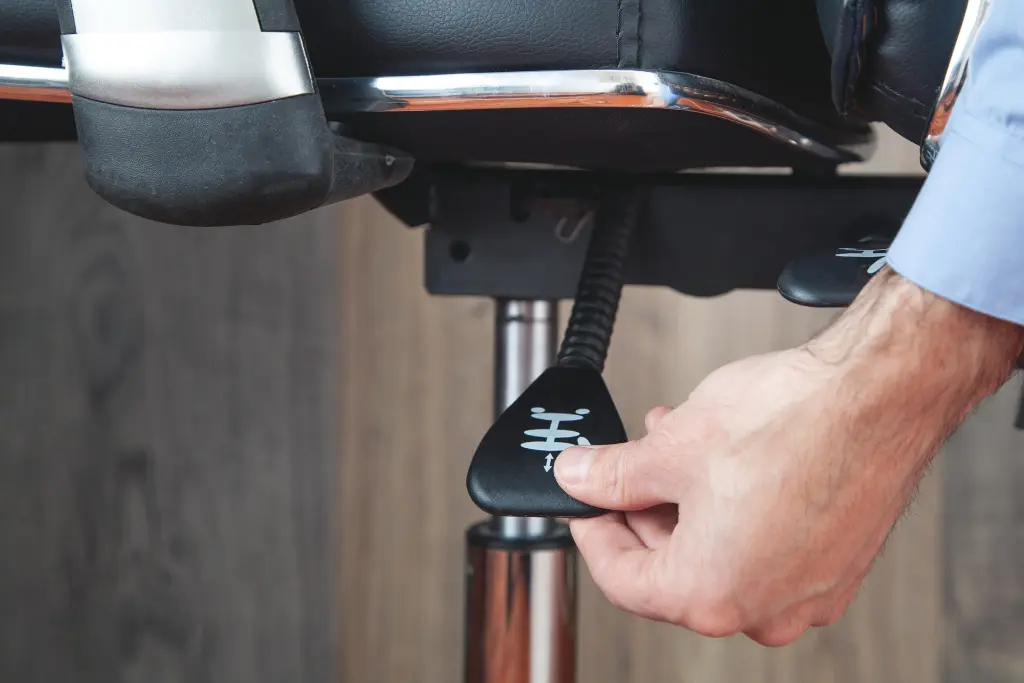Do you spend lots of time sitting at a desk each day? Wouldn’t it be nice if your office chair was super comfy? Well, this article is all about making adjustments so your chair fits just right.
The right setup can be the difference between dragging through the afternoon with a sore back or floating into the evening feeling supported. But with all the levers and knobs, chairs can seem confusing.
Luckily I’m going to walk you through each part that changes, showing what to look for and fix so your chair feels great. By the end, you’ll be a pro at Office chair adjustments to find your perfect sitting position.
Are you ready to discover how easy it is to feel good all day long? Then let’s get started tweaking your office chair!
Armrest Adjustments
The armrests are a good place to start. They can usually move up/down and in/out. When fixing them, you want your arms to hang at your sides in a relaxed way. The following are some targets to work for:
- Height – Set them just underneath your elbows so your arms don’t have to stretch up. This prevents squeezing in your shoulders.
- Width – Align them with your torso for balanced shoulders. Don’t go too far in or out to avoid pain there or in your wrists.
- Padding – Look for cushiony pads that softly cradle your whole arms with no pressure points.
With the armrests fitting well, it’s easier to sit up straight instead of slouching forward, which can be hard on your back over time. Take a minute to set them how you like.
Backrest Adjustments
After that, focus on tweaking the back part. This is super important for a happy back. You want it curved just right to fully hug your lower and upper back. Start by making sure the middle comfortably hits the small of your back. Then see if you can tune up the lumbar cushion in that lower area too. Also, check if the tilt locks stay put when you lean back a bit. Here are the backrest settings to aim for:
- Height – The small of your back should firmly contact the curved center part of the backrest without feeling scrunched. Adjust the height so your hips are slightly higher than your knees.
- Lumbar Support – Look for an adjustable lumbar pad to contour to the natural inward curve of your lower back. Position it at the small of your back for added support in this vulnerable area.
- Tilt Tension – The backrest should recline just enough for an upright-yet-relaxed 115-125 degree sitting angle to avoid slouching. Adjust the tilt tension dial so it doesn’t wobble back too easily.

Making these simple backrest adjustments will keep your spine properly aligned whether leaning back or sitting up straight at your desk. Test different heights and contours to find a customized “hug” of support.
Seat Depth Adjustment
In addition to backrest tailoring, don’t forget about optimizing the depth of the seat itself. Your knees should neatly fit under the desk and not jut out at an angle when seated all the way back against the backrest. To check the ideal seat depth:
- Sit all the way back with your lower back supported against the adjusted backrest.
Related: How to Adjust Office Chair Seat Angle – An Ultimate Guide
- Your thighs should be parallel to the floor and your knees bent at a right angle. If they are cramped, increase the seat depth.
- Your feet should easily reach the ground. Adjust the seat height up or down if needed.

With the correct seat depth, your whole body will feel well-balanced and supported without any part hanging off the edge of the seat. This prevents premature fatigue and possible leg numbness issues.
Tilt Lock Function
Although we want a gently reclined position for ergonomic benefits, having full control over the tilt angle is important too. Look for a tilt lock mechanism that lets you securely fix the backrest angle anywhere between fully upright and fully reclined. Here are some reasons to use the lock function:
- When reading or editing documents, you may need a more vertical back angle for easier viewing.
- During conference calls or video meetings, lock the backrest upright so you appear attentive to others.
- When taking short breaks, you can recline further back using the tilt function but lock it before getting back to work to motivate yourself to stay productive.
Related: How to Fix an Office Chair That Leans Back – A Comprehensive Guide
Overall, having the ability to lock the tilt maintains discretionary control over your sitting posture depending on activity. It also prevents unwanted slumping that may occur without the lock engaged.
Lumbar Support Pillow
While lumbar pads built into the chair backrest work well for many, an additional detachable lumbar pillow can further customize support. Here are some reasons a portable lumbar pillow is worth considering:
- Alternative curves – Provides differing levels of inward curve if the chair’s built-in lumbar doesn’t hit the right spot.
- Adjustable firmness – This can be stuffed with more or less filling for a firmer or softer contour than the chair’s permanent pad.
- Portability – Carry it along when using other chairs on occasion for support anywhere you need it.
- Alternative positions – Use in the car, on the couch or in bed if soreness occurs elsewhere besides your office chair.
Look for a breathable fabric pillow that molds snugly around your lower back for targeted compression where kinks may occur. Consider it as an extra tool to maximize lower back support anywhere.
Chair Material and Design
While adjustments are important, the base chair material and design affect comfort too. Here are some attributes to seek:
- Mesh back – Provides ventilation and avoids overheating compared to thickly padded materials. Less pronounced welts are smoother on the back.
- Pneumatic height control – Smoothly raises or lowers the chair with a lever for customizable desk fitting. Bolt systems jerk more.
- Multifunctional tilt – Tilts together with a synchro tilt for full back and seat tilt functions or just the back for a partial recline.
- Adjustable armrests – As discussed earlier, movable armrests permit customization and fewer pressure points on shoulders and arms.
- Cushioning – Balanced firm yet cushioned seat and back for support without feeling sunken in or elevated prominently.
Selecting a chair with ergonomic design principles in mind, along with quality adjustments, delivers long-term sitting comfort during work tasks.
Accessories for Added Comfort
While performing proper office chair adjustments is important, additional accessories can boost comfort even further:
- Footrest – Elevates feet for improved posture when sitting for hours.
- Lumbar support cushion – Adds extra personalized lower back shaping beyond the chair’s built-in curve.
- Wrist rest – Supports wrists in a neutral position to avoid fatigue on desktops.
- Headrest cushion – Provides neck support, especially for taller users who want full relief.
Try different accessories until you discover what extra areas need relief for your body type. Just be sure large add-ons don’t get in the way of your chair’s intended adjustments.
Proper Maintenance of Office Chair
Even the best office chair will break down faster without proper care and maintenance. Here are some simple tips:
- Vacuum or wipe off crumbs and dust regularly from the fabric or mesh.
- Check wheels and pumps monthly for proper lubrication with silicone spray.
- Inspect parts like arms, pistons, and gas springs and tighten any loose screws.
- Rotate the chair 180 degrees every few months to promote even wear and tear.
- Re-adjust seating every time you notice slumping to prevent permanent formation.
Taking a few minutes each week to check components ensures your chair ages gracefully providing optimal comfort and support for years to come.
Final Thoughts
In conclusion, making informed office chair adjustments should be a top priority whether working from home or the office. By customizing the armrest positioning, backrest height and tilt, and seat depth, and with optional lumbar aids – your spine, shoulders, arms and legs will properly align for healthy sitting. Be sure to periodically readjust the chair as your body changes and needs to evolve over time. With the keys we discussed, you’ll be empowered to find an optimized comfortable seated position that promotes productivity and prevents unnecessary physical strain. Remember – a few minutes spent adjusting your office chair correctly pays big dividends in back health long term. So get adjusting that seat today!
Frequently Asked Questions (FAQs)
Here are some potential FAQs with simple answers for the office chair adjustments article:
Q: What if my chair is really old and doesn’t adjust much?
Even older chairs can usually adjust the height at least. You can also consider adding a lumbar pillow for extra back support. Proper posture is still key too.
Q: How often should I readjust my chair?
It’s a good idea to tweak your settings every few months as your body may change slightly. Or if you start feeling new discomfort, it could be time to re-optimize.
Q: Can adjustments help with back/hip/shoulder pain?
Yes, proper positioning through adjustments can absolutely help reduce strains that lead to such pain over time. Slight tweaks make a big difference in taking pressure off problem areas.
Q: What if my adjustments don’t seem right after?
Don’t worry, it takes time to dial in the perfect fit. Keep experimenting with small changes until you feel supported and pain-free. And go slowly when reclining at first.
Q: Any tips for short/tall people?
For short folks, try raising the seat higher. Tall people may lower it and adjust the lumbar support up higher. Armrests too can change based on height.
Q: Can I use these tips whether at work or home?
Definitely, the same ergonomic principles apply no matter where you sit for long periods. Customize for comfort anywhere.







